Out of the three different kinds of reloading
Choosing a single stage press comes down to press durability and consistency of loads. A properly configured press will allow you to get the best performance out of your guns.
Not even the best single stage press can compete with a budget turret or progressive
What is The Best Single Stage Reloading Press?
1) RCBS Rock Chucker Supreme Master Reloading Kit
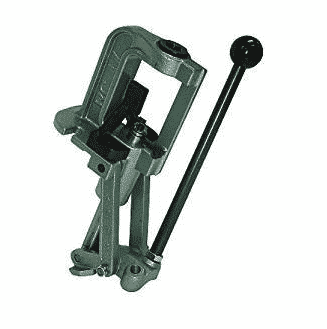
Notable Features:
- Extremely Durable Design
- Includes Everything Needed to Start
- Ambidextrous Control Arm
Kit With Everything Needed to Start Reloading
The RCBS Rock Chucker Supreme Master Reloading Kit includes everything that a beginner loader will need. You can also buy just the Rock Chucker Press without all the extra accessories.
RCBS products have been around for over 60 years and produce a quality product. The Rock Chucker press has a very smooth operating handle that offers an ambidextrous control arm.
Individual left and
Also included in this kit is the M500 Mechanical Scale, Uniflow Powder Measure, Hand Priming Tool, Universal Case Load Block, Debur Tool, Case Lube kit and Nosler #7 Reloading Manual.
The RCBS M500 Mechanical Scale is one of the best
The RCBS hand priming tool not only seats your primer quickly but
The Uniflow Powder Measure is one of the most accurate powder measures. The majority of Powders pour uniformly from the measuring cylinder into your case. This should eliminate the hazards of overloads caused by clogging when charges are dumped.
The Nosler #7 Reloading manual is also included. This is one of many reloading books that every reloader should own. Nosler makes a very thorough,
2) Hornady Lock N Load Classic Reloading Press Kit
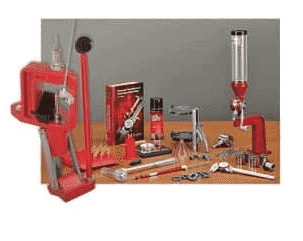
Notable Features:
- Durable Design
- Moderately Priced
- Quick Swapping Dies
Deluxe Reloading Kit Available Here
The Hornady Lock N Load Classic Reloading Press Kit is right up there with the RCBS single stage reloading kit. Overall Hornady’s single stage reloading press is a very solid unit.
There are two main differences between the RCBS and Hornady single stage reloading presses. The first difference is the Hornady press is not designed to be used by
This doesn’t mean
The second difference is that the Hornady single stage press uses their patented lock n load system. The lock n load bushings really do speed up the reloading process on a single stage press since you don’t have to make adjustments every time to your reloading dies. You can actually buy a Hornady Lock n Load conversion kit that can be used on any reloading press.
Other than the press the two main differences between the Hornady Kit and the RCBS Kit are the reloading manual and scale. The Hornady kit includes the Hornady Handbook of Cartridge Reloading and more.
This is a pretty good book for load data especially if you use Hornady’s bullets. Load data for almost all of Hornady’s bullets are included in this book. The only real problem I have found with this book is a lack of data for cast lead bullets. I enjoy casting my own bullets so this was a real problem for me. Hornady’s inclusion of a digital scale is a huge plus for me.
The first thing that anyone who owns a manual scale does is buys a digital scale. Once I bought my digital scale the only thing I used my manual scale for is checking drift in my scale.
Digital scales normally come with a weight to check your scales accuracy as well. If I was going to choose a single stage reloading press kit I would choose Hornady’s.
You may also want to
3. Lee Precision Anniversary Challenger Kit II
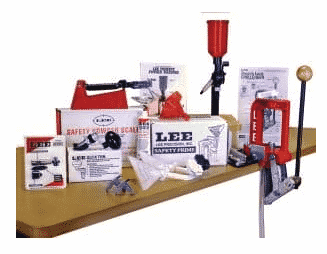
You may have noticed that I didn’t include the Lee Single Stage kit in my above comparisons. This isn’t because the Lee press is bad, it’s because the Lee kit is in a significantly different price range to the above presses.
Lee actually has 3 single stage presses that all vary greatly in price. Their most basic press is a
The Lee Challenger Press which is Lee’s middle of the range single stage press. The Lee Challenger press is what’s included in this kit. The final single stage press they have is the Lee Classic Cast Press which is Lee’s most expensive single stage press made out of Cast Iron.
The Lee Challenger Press is a great press if you’re on a tight budget. It will do almost everything that the more expensive single stage presses will do at a fraction of the price.
The only real difference between this press and the others is the thickness, but I honestly have a hard time believing anyone is destroying these presses.
You would have to put some serious force onto this press to bend the thing and the brass case should bend before this press does. You can even install the Hornady Lock N Load Conversion kit onto this press to give it all the same features as the Hornady. The only real problem I’ve seen with the Lee Challenger press is that the occasional primer misses its catch basin.
The Lee Challenger Press is actually a nice little press for the money. If it were up to me I would avoid buying the kit and just purchase the challenger press, your choice in powder measure, hand priming tool,
You can probably buy all of these components for about the same price as this kit and have better components. Realistically almost everything else in this kit you will more than likely replace.
4) Lee Single Stage Reloading Press
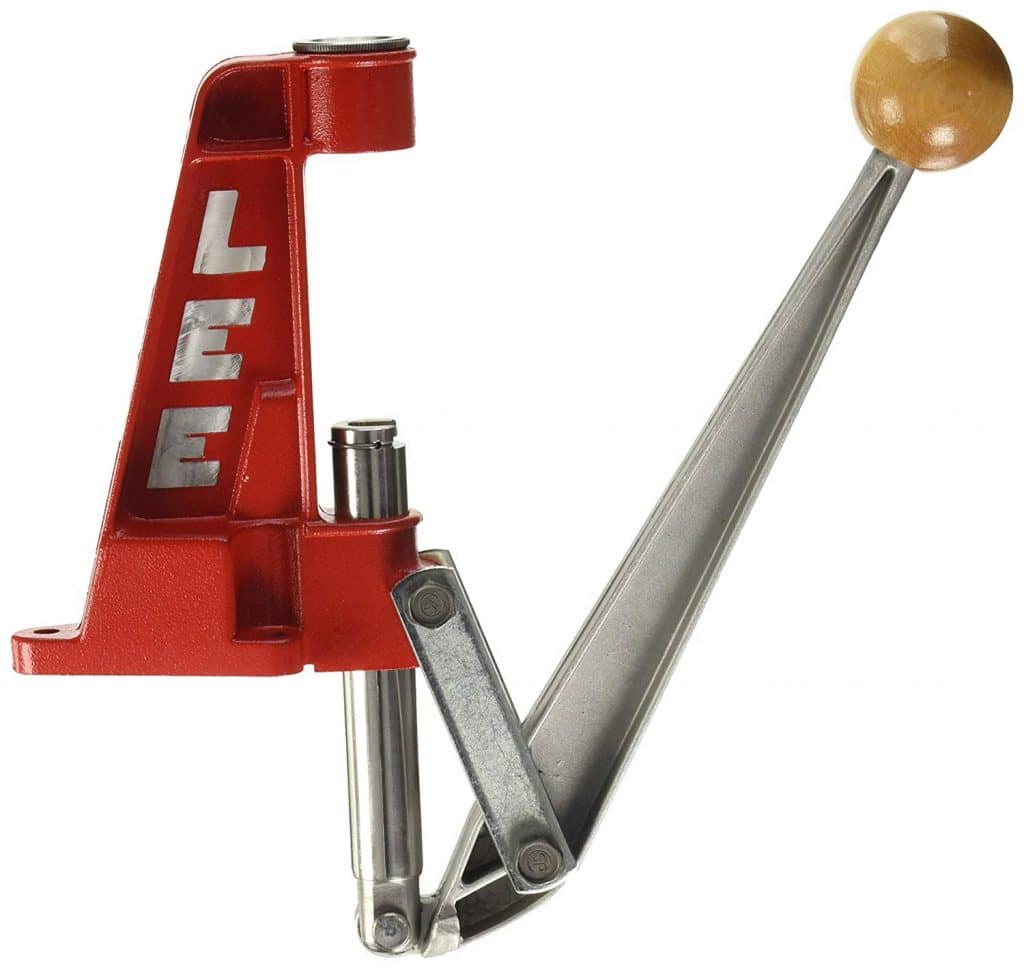

If you’re just looking for an extra single stage press for light usage check out the basic Lee Reloading press. If this is going to be your only press spend the extra money on the challenger, but this is a nice little press for the price.
Lee’s basic press is seriously cheap, but it’s surprisingly well made. Targeting the budget entry level market this press is made out of a cast aluminum and zinc body. Even though it’s lightweight it really does withstand the force of reloading.
Even though I don’t use this press exclusively I actually own a couple of them. I actually have two of these mounted with dedicated de-priming and bullet pulling dies.
I really wish the base of this press was a little bit wider. It could use some extra support to further stabilize the product. That being said it’s really not that bad. There’s also not enough room to use this press with longer rifle ammo which limits its functionality.
While this press isn’t made for heavy use it brings a lot of value for the price. At such a low price point this is the perfect first press for anybody getting into reloading.
5) RCBS Partner Press
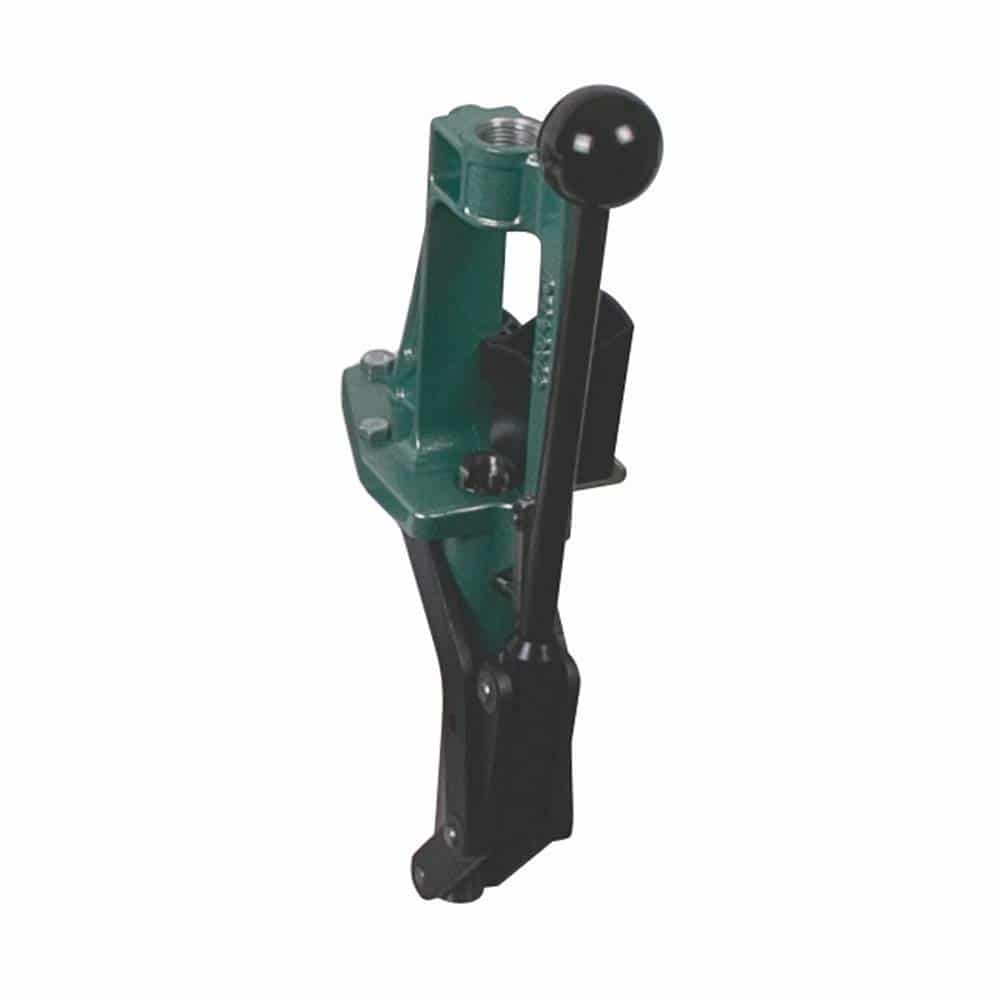

The Partner Press was RCBS answer to all the budget Lee Presses on the market. As the name implies it was designed to work as a partner alongside your primary progressive or turret press.
Most people use this press as a dedicated decapping and swaging press to compliment their primary press. They install a universal decapping die(like this one) so they don’t damage their expensive dies. It doesn’t take up much room on your bench and it’s seriously built like a tank. Made out of cast aluminum this thing will outlive me.
While this wouldn’t be my first choice as a primary press it’s the perfect compliment to a turret or progressive. You can’t go wrong with any press that RCBS produces.
6) Lee’s Classic Breech Lock
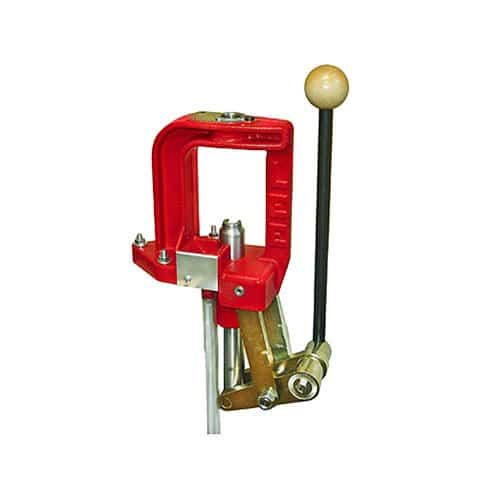
The Classic Cast Breech Lock press is about the same price as the classic cast press below, but it has one major difference. It includes the new breech lock feature that’s also found in the above challenger press.
This press uses the new breech lock quick change bushings which make reloading a breeze. You can swap dies without manually adjusting them each time. All the dies come with lock rings so once adjusted and locked down you can quickly setup new dies. Only downside is you need to purchase breech lock bushings for all your dies(check out the price)
It’s made out of a cast iron and has heavy duty construction using the old school “O” Design. This press is seriously solid and I don’t see any reason it will ever fail. The handle can be adjusted for both right and left hand as well as height.
Priming is also made simple with the auto prime unit that accommodates both small and large primers(although I prefer hand priming).
7) Lee Classic Cast Press
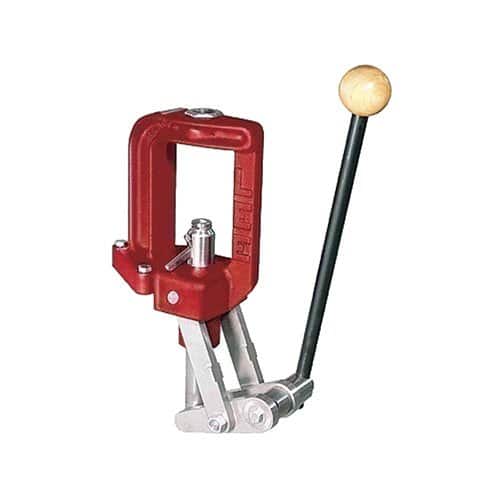
Lee’s Classic Cast press is the premium option in their lineup. It’s been around forever and withstood the test of time. Built out of cast iron and noticeably sturdier than the challenger press. It is everything you could ask for out of a single stage press.
Only problem is, with that heavy duty construction comes a high price tag. You’re better off with the challenger press listed above, unless you never plan on switching over to a progressive/turret press(which I highly recommend).
That being said, if you have the extra money you can’t go wrong with the classic cast press. It has that sturdy “O” frame that offers plenty of stability and the longest/strongest stroke handle in the industry.
You can easily switch from right to left handed operation which isn’t available on the cheaper presses and the start and stop position can be adjusted. This really is a premium press at a moderate price point.
8) Lyman Single Stage Press
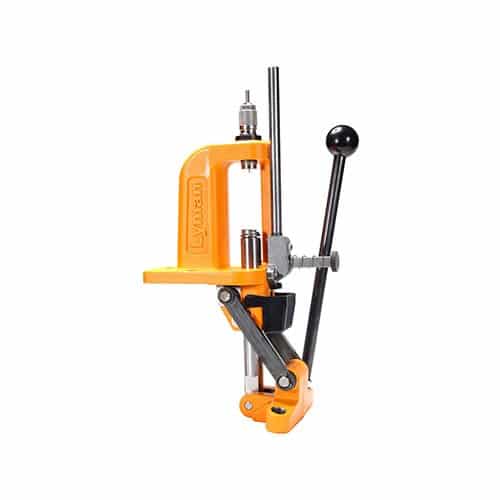
I shoot with a few guys that use the Lyman Single Stage Press and they absolutely love it. It can stand side by side with RCBS and Hornady any day. Only problem is you can never seem to find one.
Honestly, I’ve never seen a Lyman single stage in local gun stores and they’re always sold out online. If you can find one it’s one of the sturdiest reloading presses on the market(good luck).
It’s made out of a heavy duty cast iron “O” frame like all the other work horses on the market. They started out just like all the other companies with a O-Shaped frame then beefed up the ram to beef up the body.
The primer feed is the best part of this press. It’s one of the most reliable primer feeds on the market and it’s easy to use. Just bring the arm forward at the bottom of the swing to prime the brass(really simple).
Offering ambidextrous support and a sturdy body the Lyman Single Stage is well worth a look.
How Does a Single Stage Press Work?
If you’re new to reloading you might not yet know the difference between a single stage, turret
You will be able to get the most consistency out of your reloads. Though you can get consistent loads out of a progressive press nothing beats the slow refined process that a single stage press gives you. A single stage press allows you to fine tune and
Checking your bullet between every load is an important step for every beginning reloader. If you are new to reloading it’s very important to read your reloading manuals both before and while you’re reloading. You may lose your place and forget whether or not you have already dropped your charge.
With a single stage press it’s easy to look into your reloading tray and visually check for uniformity. When a beginner purchases a turret or progressive press they can quickly get in over their head and make costly and dangerous mistakes.
The focus on quality rather than production helps instill important safety measures. You will remember to inspect each case for irregularities and check to make sure you don’t accidentally double charge or undercharge your load. You will also have more time to check your powder weights on a regular basis which you can quickly become lazy about on a progressive.
So what makes up the single stage reloading press? Once all of your brass is cleaned and processed you will need to learn how to use your press.The basic single stage press is nothing more than a mechanical lever arm that pushes a piece of brass up into your set of reloading dies.
Unlike the more advanced progressive
Between each stage of your reloading
This type of press is great for both
How to Start Reloading With a Single Stage Press
Every reloading press on the market works using the same basic steps. Yes turret and progressive presses speed up the process, but you still follow the same basic setup.
Luckily single stage reloading presses are the easiest for a beginner to setup and figure out. Since you’re only focusing on one step at a time you won’t get overwhelmed and make expensive, dangerous and time consuming mistakes.
1) Buy a Reloading Manual
I don’t care how much information you can find on the internet, everybody needs to have a couple reloading manuals on hand. (check out my post on the best reloading manuals) When figuring out new loads you need to be able to double and triple check between multiple sources.
Do yourself a favor and buy more than one reloading manual. Your preferences will eventually change. Some manuals specialize in lead cast bullets while others focus more on pre-manufactured rounds. It’s all about finding the common ground between your interests.
2) Install The Press on Your Workbench
If you don’t already have a workbench at home check out my post on finding the best reloading workbench. Any solid surface will work as long as it’s sturdy.
Wherever you plan on installing you need to make sure the workbench is strong enough to withstand the force of reloading. A single stage press puts a lot of strain onto the work surface.
My dad recently purchased the cheap wooden workbench they sell at harbor freight and he really loves it(it looks like this but its like half the price).
3) Buy the Right Caliber Specific Dies
You can find reloading dies in just about every caliber imaginable. Some dies cost like $30 while others cost a few hundred bucks.
Honestly, unless you’re training to be a competitive shooter you’ll never outgrow the Lee Carbide Dies. They come with the caliber specific case holders don’t need lube, they’re built to last and come with a lifetime warranty(what more could you ask for).
Yes the RCBS, Hornady, Lyman ETC dies might be a little stronger, but they’re double the price. You might occasionally break the pin on a Lee Die but they replace them for free so who cares. Save yourself some cash and go with Lee Carbide Dies.
Choosing between 3-Die and 4-Die sets is another choice you will need to make. Throughout the years my preferences have shifted. Once I learned how to dial in the seating and crimping die the Factory Crimp was no longer necessary(except for 1 or 2 pistols with especially tight barrels).
4)Install The Shell Holders and Dies
Lee dies all come with shell holders but most of the other manufacturers make you purchase them separately. If your dies don’t have shell holders you can always buy a Universal Shell Holder Set (this is the one I use).
Follow the manufacturers directions to setup your first die. You might want to check out a few youtube videos before starting. When figuring out a load I always start by making ten rounds and testing them. I’ll then slightly adjust the formula until I like what I see.
5) Run Through The Reloading Stages
When using a single stage press you run all your brass through one stage at a time. Before starting make sure all your brass is prepped and cleaned. Install your shell holder and sizing die and run through your initial batch of ammo. Check the length and trim if necessary(chamfer,deburr rifle ammo).
Expand the case mouth of straight wall cartridges and prime the case. You can either prime the case with your press or use a seperate hand primer. Personally I always use the RCBS hand priming tool because most presses have finicky automatic primers(it’s just easier to hand prime).
Use a powder measure and digital scale to dial in your charge. Your powder charge is going to be brand, caliber, lead weight and bullet type specific. Make sure you double and triple check your loads in a reloading manual before proceeding. I would recommend starting off with a powder that has a wide safety range for your chosen caliber.
Use the bullet seating die to fully seat and crimp your rounds. Some reloaders choose to use a factory crimp die following the seating die. It’s all a matter of personal preference.
Why Use a Single Stage Reloading Press?
The biggest reason to use a single stage reloading press is to learn the proper way to develop a load. With a single stage press it is far easier to learn every step in the reloading process.
It is much easier to practice safe reloading methods like checking your charge frequently. You will also quickly learn how to properly adjust your reloading dies since you have to do it between each step.
It’s easier to develop
Throughout the years
At least when I use my single stage press I’m not tempted to make hundreds of bullets before I know the accuracy of my load. The single stage allows me to work up loads quickly and try out different charges in one batch. This has saved me from having to take countless rounds through my bullet puller to salvage components.
Will My Press Become Obsolete?
Everyone that I’ve taught to reload eventually asks me if their Single Stage press will eventually become obsolete. The quick answer would be yes, eventually you will want to move into a turret or progressive press.
If you are a serious shooter you will eventually realize that what you can do in 8 hours with a single stage press an experienced reloader can do in two hours with a progressive. That doesn’t mean that you won’t still use your Single Stage Press.
I have actually bought extra single stage presses to keep on my reloading workbench since I bought my first progressive. Due to the low cost of a single stage press I have two on my bench that I use as dedicated de-priming and bullet pulling stations.
Whenever I develop a new load it’s done on one of my Single Stage Presses. It’s much easier to develop a new load(normally a batch of 50) with a single stage press. If my gun isn’t properly ejecting or I’m not getting consistent patterns off the bench I will go back to the single stage press and rework my loads.
Which Press Should You Choose?
Every single stage press does exactly the same thing, a lever forces a piece of brass through a die. Whether or not you choose the most durable expensive single stage press or the cheapest single stage press will depend on what your using it for.
It wouldn’t make sense to buy the most expensive
If you’re like me and want to use it to develop
What Else Will You Need to Buy With one of These Kits?
These Single Stage reloading kits will give you almost everything that you need to buy. Unless you are buying the Hornady Kit one of the first things that you will want to buy is a digital scale.
Though this isn’t entirely necessary it will definitely speed up the reloading process. Loading with a single stage press is slow so anything that you can do to speed up the process is a step in the right direction. You will want to buy additional reloading manuals.
You can never have enough reloading manuals, but one or two should give you enough load data to figure out your first load. You need a set of reloading dies. It doesn’t matter which brand you decide to purchase they are all interchangeable between the different brands of reloading presses. You can buy optional accessories like a bullet puller or case prep center to increase your reloading efficiency.
So What is The Best Reloading Press?
If you’re looking for a
The RCBS Single stage press would be much better for someone who is
The ability to place this press anywhere versus the Hornady needing to be on your right side could be a deciding factor. You might also want to consider that if you ever want to upgrade to a Progressive Press like the Hornady Lock n Load ap which can only be mounted on your right side, you might need to change your mounting location.
If you are on a tight budget or probably going to upgrade quickly than the Lee Challenger is a solid option. It doesn’t make sense to spend a lot of cash if you’re going to upgrade to a faster press in a few months. Which if you’re shooting nearly as much as me you will probably want to.
It won’t cost a fortune to be able to load any caliber of your choosing. You may also want to check out the Lee Classic Cast Single stage press because it is also a very nice press.
If you have the extra money to spend you can’t go wrong with the Hornady or RCBS single stage reloading press. For the budget oriented consumer the Lee Challenger is the best press to purchase.
Useful Tips
- Consider a Heavy Duty Press: A reloading press that’s made out of cast iron is going to last longer than one out of aluminum. However, if you plan on eventually upgrading to progressive you can save a little money on a cheaper press.
- Buy Quick Change Bushings: Quick change bushings like the ones sold by Hornady and Lee will significantly speed up your reloading. Most people can work a single stage press at about the same speed as a turret with a little practice.
- Don’t Overspend on Dies: Most reloaders will never notice a difference between Lee, Hornady, Lyman, RCBS dies so there’s no need to pay the premium. You can also save money by going with a 3-die set and skipping the factory crimp die.
- Buy Carbide Pistol Dies: Always buy carbide dies when available. With carbide dies you don’t need to use case lube during the loading process.
- Turret Press can Be Used in Single Stage: If you eventually plan on moving up to a turret press you should skip the single stage. Most turret presses can be used without the auto-indexing feature which gives you the same functionality as a single stage press.
- Look For Ambidextrous Handles: Not every single stage press is going to offer an ambidextrous handle. Left handed reloaders seem to prefer the rock chucker over the other single stage presses.
- Longer Rifle Brass Might Not Fit: A cheap single stage press is great for pistol and most rifle brass, but longer brass isn’t going to fit. Make sure the press will handle the cartridges you want to reload.
- Plan on Upgrading Soon: If you stick with reloading you will eventually want to switch to a progressive press. With a progressive press you’ll be able to load 5-10 times the ammo per hour. Check out my post on the best progressive press.
FAQ
- Would You Recommend a Single Stage Press for a beginner?: Yes I would definitely recommend starting off on either a single stage or turret press. Breaking down the reloading process into multiple simple stages makes everything easier. You can learn on a progressive, but simple mistakes will be multiplied over lots of rounds fast.
- Is one Brand Better Than The Rest?: My favorite brand was always RCBS, but Hornady has really stepped up their game in the past couple years. Lee also makes great products if you’re looking for budget offerings.
- Should I Use a Single Stage For Decapping/Depriming?: When using once fired brass you should remove the spent primers before placing your brass in the tumbler. This isn’t much of an issue when using a single stage, but with progressives you’ll have to remove all the dies. Having a dedicated universal decapping setup will speed up the process.
- Should I buy 3 or 4 die sets: If you have the extra cash you can’t go wrong with a 4 die set that includes the factory crimp die. However, with a little practice most reloaders can get good crimps without the factory crimp die(so it’s a matter of personal preference).
- How Fast Can You Reload With a Single Stage Press?: With a little practice most reloaders can pump out at least 100 rounds per hour. The key is working in batches and making sure all your brass is prepped and ready to go.
- Will Reloading Save Me Money?: Very few people save money by getting into reloading. Equipment is expensive and you will inevitably shoot 5 times more. You can save money if you go with a modest setup, but reloading is meant to be fun. Most of us catch the reloading bug and end up buying more and more equipment. When I can’t get out to shoot I can spend time reloading it’s just one more aspect of my shooting hobby.







